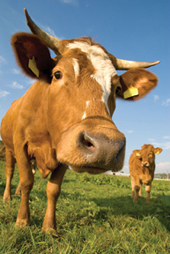Module 1 Intro
1. Module 1 Intro
1.13. Page 4
Module 1—Energy Flow and the Cycling of Matter
 Read
Read
As a summary of Chapter 1 of your textbook, read page 29 from the book.
 Try This
Try This
TR 4. Answer question 10 on page 27 of your textbook. Be sure to answer all parts of the question, and clearly show your calculations. Be sure to use significant digits when possible. Check the following box to see metric conversions.
TR 4.
1000 g = 1 kg
1 t = 1000 kg
1000 J = 1 kJ
 Reflect and Connect
Reflect and Connect

© Heiko Potthoff/iStockphoto
Remember the diagram from Lesson 1 that you completed and stored in your course folder? Now that you know more about energy flow through trophic levels, how could you modify the diagram? Complete your additions and save the diagram to your course folder. The diagram will be revisited. This should help you with the following assignment (Investigation 1.B).
Complete the following investigation. Save it to your course folder.
 Lesson 2: Assignment
Lesson 2: Assignment
Refer to Lesson 2: Assignment and complete Investigation 1.B.
 Investigation 1.B: Weave Your Own Food Web
Investigation 1.B: Weave Your Own Food Web
Complete “Investigation 1.B” on pages 22 and 23 of your textbook. Post your Investigation answers to the discussion area. See below to get a tutorial on how to perform the calculations.
 Self-Check
Self-Check
SC 6. Answer questions 7 and 8 on page 27 of the textbook.
SC 7. Answer questions 1, 5, 9, 12, 16, and 19 on pages 30 and 31.
 Self-Check Answers
Self-Check Answers
SC 6.
7. The unit area in a measure of biomass provides a basis of comparison and can be considered a controlled variable. Without including the unit area, comparisons of dry weight would be meaningless.
8. a) less producers = less energy for higher trophic levels (limits food supplies) = less organisms at each trophic level
b) more secondary consumers = less primary consumers = more producers → there would be more energy available for primary consumers
SC 7.
1. Decomposers feed on once living or organic matter to survive; they are not creating their own energy.
5. The spring melt is starting earlier, the sea ice is thin, and the weather is unusual. These observations coincide with scientific data.
9. a) Species have varied diets. For example, people eat vegetables (primary consumer) but also eat fish (tertiary consumer).
b) When an organism is not dependent on only one food source, the chances of it surviving a year where that food source was scarce is increased. When organisms can ensure survival through hardship (fluctuations in energy flow), an ecosystem has greater stability (greater biodiversity = greater stability).
12. Seasons (winter—snow covered and leaves are gone), drought, and the amount and intensity of sunlight can limit growth.
16. The relative number of producers that can support consumers is greater in a grassland due to the size of the producer; an aspen tree can support many primary consumers due to its size.
19. a) producer to primary consumer—rule of 10—1 kg X 10 = 10 kg of strawberries would have to be eaten for you to gain 1 kg of mass.
b) producer to primary consumer to secondary consumer to tertiary consumer—rule of 10—1 kg x 10 x 10 x 10 = 1000 kg of plant material would be consumed through this food chain so that you could gain 1 kg of mass.
 Discuss
Discuss
 Assignment
Assignment
Use information from the activity in Reflect and Connect, and from any other activity that you completed, to respond to the following question: Should vegetarianism be encouraged in Canada? Identify the benefits/risks of the Canadian population adopting total vegetarianism.
These discussions are a place where you can share ideas and opinions, so put some thought into your posting! Respond to at least one other classmate's posting.
Discussion Guide
| Expectations | Excellent (3) |
Fair (2) |
Poor (1) |
Incomplete (0) |
|---|---|---|---|---|
Completeness (X6) |
The student clearly states a position and provides relevant support (facts, figures, uses specific vocabulary in context). | The student states a position and provides support (facts, figures, uses specific vocabulary). | The student does not take a position. The information has some validity but lacks focus. | The student did not answer the question. |
| Insight | The student demonstrates an excellent understanding of the question.
|
The student demonstrates a good understanding of the question, but seems a bit confused with some of the answers.
|
The student gives confusing answers and does not seem to understand. |
The student did not complete the investigation. |
| Total | 21 marks | |||
 Reflect on the Big Picture
Reflect on the Big Picture
What is energy? For most organisms, it comes from what they eat. As you stand outside, possibly in your backyard, you should have a better appreciation for the importance of plants. You should also have an understanding of why people are outnumbered, and you should possess the ability to compare the transfer of energy in your ecosystem with that of an aquatic or extreme (deep sea or arctic) ecosystem. You have now mastered how energy flows and are now heading to the realm of cycling matter.
 Module 1: Lesson 2 Assignment
Module 1: Lesson 2 Assignment
Remember to submit the Assignment answers to your teacher as part of your Module 1: Lesson 2 Assignment.